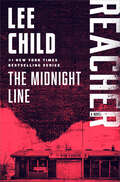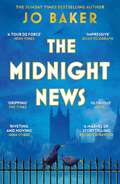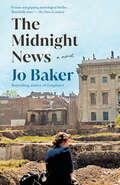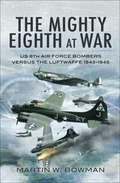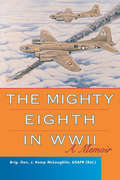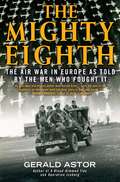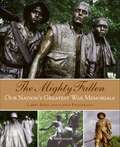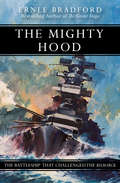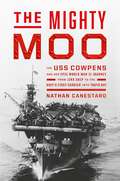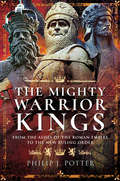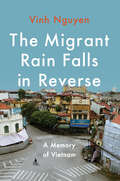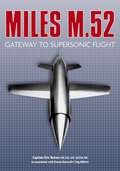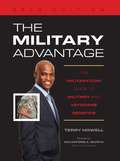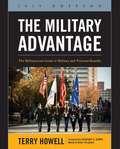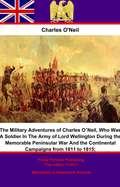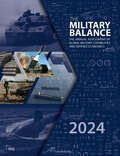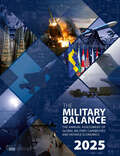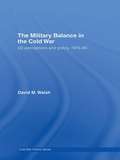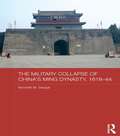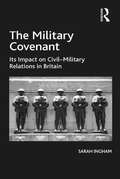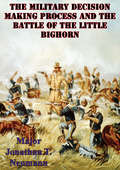- Table View
- List View
The Midnight House (John Wells Series #4)
by Alex BerensonEarly one morning, a former CIA agent is shot to death in the street. That night, an army vet is gunned down in his doorway. The next day, John Wells gets a phone call. Come to Langley. Now. The two victims were part of an eleven-member interrogation team that operated out of a secret base in Poland called the Midnight House. For two years, they put the screws to the toughest jihadis, men thought to have knowledge of imminent threats. The interrogators used whatever means necessary. When they were disbanded in the wake of public controversy, they were given medals for their heroism, Prozac for their nightmares. Now Wells must find out who is killing them. Islamic terrorists are the likeliest explanation, and Wells is uniquely qualified to go undercover after them. But the trail of blood he discovers will lead him and his boss, Ellis Shafer, to a place they wouldn't have imagined-and leave Wells facing the hardest of questions about the men of the Midnight House.
The Midnight House: A spellbinding big house mystery set in beautiful Ireland and WW2 London for lovers of historical fiction
by Amanda GeardPeople disappear. Secrets remain...'A wonderful tale of family secrets. Compelling, intriguing, and brimming with lush historical detail' HAZEL GAYNOR, New York Times bestselling author of The Bird in the Bamboo Cage'I really, really loved it. Written in that old-school, descriptively beautiful way I just love and adore. A wonderful mystery, and then another mystery thrown in, totally atmospheric and just wonderfully escapist' LORNA COOK, USA Today bestselling author of The Girl from the Island_________________________My Dearest T, Whatever you hear, do not believe it for a moment...1940: In south-west Ireland, the young and beautiful Lady Charlotte Rathmore is pronounced dead after she mysteriously disappears by the lake of Blackwater Hall. In London, on the brink of the Blitz, Nancy Rathmore is grieving Charlotte's death when a letter arrives containing a secret that she is sworn to keep - one that will change her life for ever.2019: Decades later, Ellie Fitzgerald is forced to leave Dublin disgraced and heartbroken. Abandoning journalism, she returns to rural Kerry to weather out the storm. But, when she discovers a faded letter, tucked inside the pages of an old book, she finds herself drawn in by a long-buried secret. And as Ellie begins to unravel the mystery, it becomes clear that the letter might hold the key to more than just Charlotte's disappearance.An unforgettable and spellbinding story of secrets, war, love and sacrifice, perfect for readers of Kate Morton, Eve Chase and Louise Douglas.(P) 2022 Headline Publishing Group Ltd
The Midnight House: Curl up with this rich, spellbinding Richard and Judy Book Club read of love and war
by Amanda GeardThe spellbinding RICHARD AND JUDY BOOKCLUB PICK about a mysterious house and an old family secret . . .'Wonderful storytelling. I loved it' RACHEL HORE'A wonderful tale of family secrets, brimming with lush historical detail' HAZEL GAYNOR'A mesmerising debut novel, lush and gorgeous, with a rich family tale to tell' RICHARD AND JUDY BOOK CLUB _______ People disappear. Secrets remain . . . 1940: In south-west Ireland, the young and beautiful Lady Charlotte Rathmore is pronounced dead after she mysteriously disappears by the lake of Blackwater Hall. In London, on the brink of the Blitz, Nancy Rathmore is grieving Charlotte's death when a letter arrives containing a secret that she is sworn to keep - one that will change her life for ever. 2019: Disgraced young journalist Ellie Fitzgerald flees Dublin for the safety of rural Kerry. When she discovers a faded letter, tucked inside the pages of an old book from Blackwater Hall, she finds herself drawn in by the mystery of Lady Charlotte's disappearance, and uncovers a long-buried secret...Sweeping from the wilds of beautiful Ireland to wartime London, this is perfect for fans of Kate Morton, Eve Chase and Lucinda Riley.** DON'T MISS THE NEW NOVEL FROM AMANDA GEARD, THE MOON GATE, AVAILABLE NOW ** _______ 'I was pulled in from page one. It's beautiful' LIZ FENWICK'A mystery spanning generations, evocative and beautifully written' TRACEY REES'I really loved it. A wonderful mystery. Atmospheric and wonderfully escapist' LORNA COOK 'A gorgeous setting, wonderful characters and secrets that kept me glued to the pages' JENNY ASHCROFT 'Intriguing, moving and I loved the way the stories moved back and forth in time' SINÉAD MORIARTYReal readers adore this book... '⭐ ⭐ ⭐ ⭐ ⭐Love love love this book! Fabulous female characters. I was totally invested in the story. I couldn't wait to get back to it' '⭐ ⭐ ⭐ ⭐ ⭐I was absolutely captivated. Wonderful and rich. I couldn't put it down' '⭐ ⭐ ⭐ ⭐ ⭐'A wonderful read and a spellbinding mystery with wonderful characters that leap off the page. This was beautifully written with the story spanning generations' '⭐ ⭐ ⭐ ⭐ ⭐'I have been completely immersed and unwilling to put this one down. This is an absolute gem and a must. A beautiful story' '⭐ ⭐ ⭐ ⭐ ⭐'I've been reading a lot of dual time books, and this one has to be up there with the best . . . a brilliant read'
The Midnight House: Curl up with this rich, spellbinding Richard and Judy Book Club read of love and war
by Amanda GeardThe spellbinding RICHARD AND JUDY BOOKCLUB PICK about a mysterious house and an old family secret . . .'Wonderful storytelling. I loved it' RACHEL HORE'A wonderful tale of family secrets, brimming with lush historical detail' HAZEL GAYNOR'A mesmerising debut novel, lush and gorgeous, with a rich family tale to tell' RICHARD AND JUDY BOOK CLUB _______ People disappear. Secrets remain . . . 1940: In south-west Ireland, the young and beautiful Lady Charlotte Rathmore is pronounced dead after she mysteriously disappears by the lake of Blackwater Hall. In London, on the brink of the Blitz, Nancy Rathmore is grieving Charlotte's death when a letter arrives containing a secret that she is sworn to keep - one that will change her life for ever. 2019: Disgraced young journalist Ellie Fitzgerald flees Dublin for the safety of rural Kerry. When she discovers a faded letter, tucked inside the pages of an old book from Blackwater Hall, she finds herself drawn in by the mystery of Lady Charlotte's disappearance, and uncovers a long-buried secret...Sweeping from the wilds of beautiful Ireland to wartime London, this is perfect for fans of Kate Morton, Eve Chase and Lucinda Riley.** DON'T MISS THE NEW NOVEL FROM AMANDA GEARD, THE MOON GATE, AVAILABLE NOW ** _______ 'I was pulled in from page one. It's beautiful' LIZ FENWICK'A mystery spanning generations, evocative and beautifully written' TRACEY REES'I really loved it. A wonderful mystery. Atmospheric and wonderfully escapist' LORNA COOK 'A gorgeous setting, wonderful characters and secrets that kept me glued to the pages' JENNY ASHCROFT 'Intriguing, moving and I loved the way the stories moved back and forth in time' SINÉAD MORIARTYReal readers adore this book... '⭐ ⭐ ⭐ ⭐ ⭐Love love love this book! Fabulous female characters. I was totally invested in the story. I couldn't wait to get back to it' '⭐ ⭐ ⭐ ⭐ ⭐I was absolutely captivated. Wonderful and rich. I couldn't put it down' '⭐ ⭐ ⭐ ⭐ ⭐'A wonderful read and a spellbinding mystery with wonderful characters that leap off the page. This was beautifully written with the story spanning generations' '⭐ ⭐ ⭐ ⭐ ⭐'I have been completely immersed and unwilling to put this one down. This is an absolute gem and a must. A beautiful story' '⭐ ⭐ ⭐ ⭐ ⭐'I've been reading a lot of dual time books, and this one has to be up there with the best . . . a brilliant read'
The Midnight Line: A Jack Reacher Novel (Jack Reacher #22)
by Lee Child#1 NEW YORK TIMES BESTSELLER • Lee Child returns with a gripping powerhouse thriller featuring Jack Reacher, &“one of this century&’s most original, tantalizing pop-fiction heroes&” (The Washington Post).Don&’t miss the hit streaming series Reacher!Reacher takes a stroll through a small Wisconsin town and sees a class ring in a pawn shop window: West Point 2005. A tough year to graduate: Iraq, then Afghanistan. The ring is tiny, for a woman, and it has her initials engraved on the inside. Reacher wonders what unlucky circumstance made her give up something she earned over four hard years. He decides to find out. And find the woman. And return her ring. Why not?So begins a harrowing journey that takes Reacher through the upper Midwest, from a lowlife bar on the sad side of small town to a dirt-blown crossroads in the middle of nowhere, encountering bikers, cops, crooks, muscle, and a missing persons PI who wears a suit and a tie in the Wyoming wilderness.The deeper Reacher digs, and the more he learns, the more dangerous the terrain becomes. Turns out the ring was just a small link in a far darker chain. Powerful forces are guarding a vast criminal enterprise. Some lines should never be crossed. But then, neither should Reacher.BONUS: Includes a sneak peek of Lee Child&’s novel Past Tense.
The Midnight News
by Jo BakerIt is 1940 and twenty-year-old Charlotte Richmond watches from her attic window as enemy planes fly over London. Still grieving her beloved brother who never returned from France, she is working hard to keep her own little life ticking over: holding down a dull typist job at the Ministry of Information, sharing gin and confidences with her best friend Elena, and dodging her difficult father. She has good reason to keep her head down and stay out of trouble. She knows what happens when she makes a nuisance of herself.On her way to work she often sees the boy who feeds the birds - a source of unexpected joy amidst the rubble of the Blitz. But every day brings new scenes of devastation, and after yet another heartbreaking loss Charlotte has an uncanny sense of foreboding. Someone is stalking the darkness, targeting her friends. And now he is following her.She no longer knows who to trust. She can't even trust herself. She knows this; her family have told so her often enough. As grief and suspicion consume her, Charlotte's nerves become increasingly frayed, and soon her very freedom is under threat . . .Riveting and deeply moving, The Midnight News is a tour de force from Sunday Times bestselling author Jo Baker - a breathtaking story of friendship, love and war.
The Midnight News: A novel
by Jo BakerFrom the best-selling author of Longbourn, a gripping novel of one young woman&’s unraveling during the Blitz—a story of World War II intrigue, love, and danger • &“[A] thrilling novel…atmospheric and memorable.&” —Emma Donoghue, best-selling author of HavenIt is 1940 and twenty-year-old Charlotte Richmond watches from her attic window as enemy planes fly over London. Still grieving her beloved brother, who never returned from France, she is trying to keep herself out of trouble: holding down a typist job at the Ministry of Information, sharing gin and confidences with her best friend, Elena, and dodging her overbearing father.On her way to work she often sees the boy who feeds the birds—a source of unexpected joy amid the rubble of the Blitz. But every day brings new scenes of devastation, and after yet another heartbreaking loss Charlotte has an uncanny sense of foreboding. Someone is stalking the darkness, targeting her friends. And now he&’s following her.As grief and suspicion consume her, Charlotte&’s nerves become increasingly frayed. She no longer knows whom to trust. She can&’t even trust herself . . .Utterly riveting and hypnotic, The Midnight News is a love story, a war story, and an unforgettable journey into the fragile mind and fierce heart of an extraordinary young woman.
The Mighty Eighth at War: USAAF 8th Air Force Bombers Versus the Luftwaffe 1943–1945
by Martin W. Bowman&“Relates how the American Eighth Air Force bombers helped Britain's Royal Air Force in fighting Germany during World War II.&”—ProtoView From the beginning of World War II, the RAF&’s Bomber Command had been the only means of striking Hitler&’s Reich and its war machine. But the entry into the war of the United States—and the subsequent arrival in the UK of the Eighth Air Force—would more than double the Allied capability. The Flying Fortress and Liberator heavy bombers were mostly flown across the Atlantic by their young, green aircrew, and many succumbed en route and never arrived. Flying in northern Europe was a different ball game from American skies and it took a considerable time before the crews familiarized themselves with the vagaries of fog, low cloud, rain and snow. The American bombers bristled with defensive armament and elected to fly in close defensive formation during the day, leaving the RAF to carry out nighttime raids. With the arrival of long-range protective escort fighters, the task became a little easier. This book is the story, including many firsthand accounts, of how the American bomber force helped fight to eventual victory, by decimating German industry and transport systems—and breaking the Nazi war spirit.
The Mighty Eighth in WWII: A Memoir
by Brig. Gen. J. Kemp McLaughlin&“Told by a &‘been there, done that&’ combat commander, McLaughlin gives us precise accounts of such air battles as the devastating bombing of Schweinfurt.&”—Gen. Philip P. Ardery, author of Bomber Pilot: A Memoir of World War II On an early morning in the fall of 1942, McLaughlin&’s group set out for a raid on a French target. Immediately after dropping its bombs, McLaughlin&’s plane was hit. A huge fire burned a four-foot hole in his wing, his waist gunner bailed out, his radio operator was wounded, the plane lost all oxygen, and his pilot put on a parachute and sat on the escape hatch, waiting for the plane to explode. And this was only McLaughlin&’s first sortie. He went on to pilot the mission command plane on the second raid against Schweinfurt, the largest air raid in history, which resulted in the destruction of 70 percent of German ball bearing production capability. McLaughlin also participated in the bombing of heavy water installations in Norway. As a group leader, McLaughlin was responsible for the planning and execution of air raids, forced to follow the directives of senior (and sometimes less informed) officers. His position as one of the managers of the massive sky trains allows him to provide unique insight into the work of maintenance and armament crews, preflight briefings, and off-duty activities of the airmen. No other memoir of World War II reveals so much about both the actual bombing runs against Nazi Germany and the management of personnel and material that made those airborne armadas possible. &“Well-written, fast-paced and filled with anecdotes.&”—Bowling Green Daily News &“He laces tense battle scenes with humorous anecdotes about the famous people we met along the way.&”—Charleston Gazette
The Mighty Eighth: The Air War in Europe as Told by the Men Who Fought It
by Gerald AstorEurope has fallen. Pearl Harbor is in flames. Enter: the Eighth.In 1941 the RAF fought a desperate battle of survival against the Luftwaffe over Britain. Then, from across the Atlantic, came a new generation of American pilots, gunners, and bombardiers, a new generation of flying machines called the B-17 Flying Fortress, the B-24 Liberator, the P-47 Thunderbolt, and the P-51 Mustang fighter. Soon these brave young men were hurtling themselves and their unproven planes across the Channel and into the teeth of enemy firepower, raining down bombs on the German military machine, and going up against Hitler's best fliers in the sky.This is the dramatic oral history of the Army Air Corps and the newly created Eighth Air Force stationed in Britain, an army of hard-fighting, hard-playing flying men who suffered more fatalities than the entire U.S. Marine Corps in the Pacific campaign of World War II. Here, in their own words, are tales of survival and soul-numbing loss, of soldiers who came together to fight a kind of war that had never been fought before--and win it with their courage and their blood.But the road to victory was paved with sacrifice. From its inaugural mission on July 4, 1942, until V-E Day, the Eighth Air Force lost more men than did the entire United States Marine Corps in all its campaigns in the Pacific. The Mighty Eighth chronicles the testimony of the pilots, bombardiers, navigators, and gunners who daily put their lives on the line. Their harrowing accounts recall the excitement and terror of dogfights against Nazi aces, maneuvering explosive-laden aircraft through deadly flak barrages, and fending off waves of enemy fighters while coping with subzero temperatures.Beginning with the opening salvos from a mere dozen planes, crewmen describe the raids on Berlin and Dresden, the fiasco at Ploesti, Romania, and Black Thursday over Schweinfurt. They fell to the terror of seeing aircraft destroyed--helplessly watching as comrades crash and burn, or parachute over enemy territory, where they will attempt to evade enemy capture through the underground. Others tell of mourning downed airmen murdered by vengeful citizens and soldiers, and of those who endured captivity in POW camps. -->
The Mighty Fallen: American War Memorials
by Larry Bond f-stop FitzgeraldThe Mighty Fallen is a beautiful, evocative presentation of more than 150 never-before-seen photographs of the nation's greatest monuments and war memorials, along with text that describes the memorials and tells their stories. This extraordinary collection calls attention to the power of memory and the ways in which we immortalize people and events. As Larry Bond notes in the Introduction, "Memories of a war or battle are unpleasant, but few veterans would want them erased." This book is a unique tribute to veterans and a commemoration of some of the most significant conflicts in our history. Most battlefields leave little record of the historic confrontations that occurred there. Those who fought in epic struggles want us to remember not just the outcome, but the cost of victory and those who paid the price for the freedoms we enjoy today. Memories fade, so we raise monuments of stone and bronze to carry their message of sacrifice through the centuries. The Iwo Jima Memorial and the Vietnam Veterans Memorial in Washington DC are instantly recognizable, but there are monuments all over North America honoring more than 300 years of military service. The Mighty Fallen shows you hundreds of monuments, memorials, and statues conveying the message their designers wanted you to hear—these are more than just a date and location.
The Mighty Hood: The Battleship that Challenged the Bismarck
by Ernle BradfordThe story of the HMS Hood, the last great warship of the British Royal Navy, told by the bestselling author of Hannibal. When it was launched in 1918, the HMS Hood was the flagship of the Royal Navy. As a battle cruiser, &“The Mighty Hood&” was fast enough to evade enemy cruiser ships and powerful enough to destroy them. But for all the Hood&’s might, it had one fatal flaw: armor had been sacrificed for speed. In 1941, the Hood confronted the legendary German warship Bismarck. A salvo from the enemy penetrated the Hood&’s ammunition magazine, destroying the British ship and killing all but three of its crew. The brutal defeat marked the end of the Royal Navy&’s dominance. But it also inspired Winston Churchill&’s vow to sink the Bismarck—a vow that in time was fulfilled. Through oral history and documentary research, Ernle Bradford chronicles the Hood&’s career from design to demise, with colorful insight into life aboard the ship as well as its broader historical significance.
The Mighty Moo: The USS Cowpens and Her Epic World War II Journey from Jinx Ship to the Navy's First Carrier into Tokyo Bay
by Nathan CanestaroThe Mighty Moo is the tale of how a scrappy little World War II aircraft carrier and its untested crew earned a distinguished combat record and beat incredible odds to earn 12 battle stars in the Pacific. The USS Cowpens and her crew weren&’t your typical heroes. She was a flattop that the US Navy initially didn&’t want, with a captain nearly scapegoated for the loss of his last command, pilots who self-trained on the planes they would fly into combat, and sailors that had been in uniform barely longer than the ship had been afloat. Despite their humble origins, Cowpens and her band of second-string reservists and citizen sailors served with distinction, fighting in nearly every major carrier operation from 1943 to 1945, including the Battles of the Philippine Sea and Leyte Gulf. Together they faced a deadly typhoon that brought the ship to the verge of capsizing, and at war&’s end there was only one US aircraft carrier in Tokyo Bay to witness the Japanese surrender—The Mighty Moo. In the years to follow, Cowpens&’ service has become the wellspring for a remarkable modern tradition, both within the US Navy and the small Southern town that still celebrates her legacy with a festival every year. The Mighty Moo is a biography of a World War II aircraft carrier as told through the voices of its heroic crew—a &“Band of Brothers at sea.&”
The Mighty Warrior Kings: From the Ashes of the Roman Empire to the New Ruling Order
by Philip J. PotterThe epic victories and struggles of nine kings—from the restoration of the western Roman empire by Charlemagne to the battles of Robert the Bruce.The Mighty Warrior Kings traces the history of early Europe through the biographies of nine kings, who had the courage, determination and martial might to establish their dominance over the fragmented remnants of the Roman Empire. The book begins with Charlemagne, who united large regions of current-day France, Germany and Italy into the Holy Roman Empire and ends with Robert the Bruce, who gallantry defended Scotland against the attempted usurpation of England. There are many famous warrior kings in the book, including Alfred the Great of Wessex, whose victories over the Vikings led to the unification of England under a single ruler, William I of Normandy, whose triumph at Hastings in 1066 changed the course of English history, while Frederick I Barbarossa led his army to victory in Germany and Italy solidifying and expanding the lands under the suzerainty of the Holy Roman Emperor. Among the lesser known monarchs discussed in the work are Cnut, whose victory at the battle of Ashingdon won the English crown and resulted in the creation of the North Sea Empire, which ruled over the kingdoms of England, Denmark and Norway, while during the reign of Louis IX of France the knights of Europe answered his call for the Seven Crusade to expel the Muslims from the Holy City of Jerusalem. From Charlemagne to Robert the Bruce, the warrior kings created a new Europe with a centralized power base and set the stage for the following Age of Absolutism.“A most fascinating account.” —Firetrench
The Migrant Rain Falls in Reverse: A Memory of Vietnam
by Vinh NguyenAn unconventional memoir of conjuring the uncertain past and a long-lost homeland, and a vital document of one family&’s journey through world historyWith the fall of Saigon on April 30, 1975, the U.S. war in Vietnam ended, but the refugee crisis was only beginning. Among the millions of people who fled Vietnam by boat were Vinh Nguyen, along with his mother and siblings, and his father, who left separately and then mysteriously vanished.Decades later, Nguyen goes looking for the story of his father. What he discovers is a sea of questions drifting above sunken truths. To come to terms with the past, Nguyen must piece together the debris of history with family stories that have been scattered across generations and continents, kept for decades in broken hearts and guarded silences.The Migrant Rain Falls in Reverse takes readers on a poignant tour of disappeared refugee camps, abandoned family homes, and the lives that could have been. As the fiftieth anniversary of the end of the Vietnam War approaches, this powerful memoir is timelier and more important than ever, illuminating the stories, real and imagined, that become buried in the rubble of war.
The Miles M.52: Gateway to Supersonic Flight
by Eric Brown Dennis BancroftIn December 1943, a top secret contract (E.24/43) was awarded to Miles Aircraft. The contract was to build the world's first supersonic jet capable of 1000mph. The only reliable source of data on supersonic objects came from the Armament Research Dept and their wind tunnel tests on ammunition. From this, Miles developed an exceptionally thin-winged, bullet-shaped aircraft. the research was inexplicably passed to the Americans in 1944. By December 1945, one prototype was virtually complete. The second, destined for an attempt at the sound barrier was 80 per cent complete. In February 1946, Capt Eric Brown was confirmed as the test pilot and October 1946 was set for the supersonic trials. However, on 12 February 1946, Miles were ordered to stop production. No plausible explanation was given for the cancellation when Britain was within six months of breaking the sound barrier. Eric Brown and others directly involved including Dennis Bancroft, the Chief Aerodynamicist on the M.52, have now come together to try and finally solve the mystery behind the cancellation.
The Military Advantage
by Terry HowellThe Military Advantage, 2013 Edition, written by Terry Howell, Managing Editor for Benefits for Military.com is the essential annual reference guide to military and veteran's benefits. Published in partnership with Military.com, the nation's largest military membership organization with over 10 million members and its parent company, Monster.com, the nation's largest career and job website, this latest edition is the most reliable benefits guide for the over 30 million Americans who have answered the call to serve in the military. These valuable benefits include billions in scholarships, educational benefits, home loan guarantees, and military discounts.Due to the drawdown of forces in Iraq and Afghanistan and required budget cuts, the Department of Defense plans on reducing military forces by as many as 100,000 troops over the next five years. In response, the 2013 edition of the Military Advantage will focus on the rights and benefits available to assist service members, veterans and their families as they transition to civilian life in record numbers.The new 2013 Edition will include these key topics to help make the most of the military experience: Transition Assistance Program Changes New Veteran Employment Resources New VRAP GI Bill and Other GI Bill Updates New Spouse and Family Resources TRICARE Fee Increases Helpful tips on Preparing for Transition Changes to Military Pay and Survivor BenefitsWith this emphasis on making a successful transition to civilian life, this well-established guide will be even more relevant to active duty military, veterans, retirees, and their family members.
The Military Advantage: The Military.com Guide to Military and Veteran's Benefits (2015 Edition)
by Terry Howell<p><i>The Military Advantage, 2015 Edition</i> is the most complete annual reference guide to military and veteran’s benefits. Written by Terry Howell, managing editor for benefits for Military.com, the guide is backed by the resources of Military.com and its parent company, Monster.com. <i>The Military Advantage, 2015 Edition</i> is the most reliable benefits guide for the over 30 million Americans who have answered the call to serve in the military. These valuable benefits amount to billions in scholarships, educational benefits, home loan guarantees, and military discounts. <p>These extraordinary benefits are frequently overlooked by those serving in uniform or retired from the service. <i>The Military Advantage, 2015 Edition</i>insures that all service members and their families are aware of the availability of all of these substantial benefits. This easy-to-use reference guide is full of insider tips, little-known benefits, shortcuts, and detailed answers to frequently asked questions. While information about these military and veterans benefits is available through numerous, separate sources, this book collects all of those valuable resources into one easy to use reference guide and provides important analysis of these benefits. <p><i>The Military Advantage, 2015</i> Edition is the well-established essential guide to making the most of the military experience for active duty service members, veterans, military retirees, and family members. <p><i>The Military Advantage, 2015 Edition</i> is published in partnership with Military.com, the nation's largest military membership organization. With over 10 million members Military.com is the most trusted name in the military community for information about benefits, career, education and financial services. Military.com is owned by Monster.com, the largest career and job website.</p>
The Military Adventures of Charles O’Neil;: Who Was A Soldier In The Army of Lord Wellington During the Memorable Peninsular War And the Continental Campaigns from 1811 to 1815.
by Charles O’neilThis ebook is purpose built and is proof-read and re-type set from the original to provide an outstanding experience of reflowing text for an ebook reader. Numerous Irishmen joined the British army during the Napoleonic Wars, a great number distinguishing themselves in the heat of combat; a further few wrote memoirs or recollections such as the rogueish Mr O'Neil of Dundalk. He enlisted at the early age of seventeen and, not satisfied with his regiment, he decamped and joined the 28th regiment of Foot, known in the army as "The Slashers". He begins his work with a short summary of the war before he embarked on his adventures; he had clearly read a number of the histories that had been written and quotes the work of Napier, but certain of the stories and anecdotes appear to be those that he picked up from participants in the Peninsula. His real trials begin as he enters into the fray during the siege of Cadiz and participates in the glorious battle of Barossa under General Graham. After Wellington's movements to the north force the French to relinquish their grip on Cadiz, O'Neil moves onward to much less glorious territory: the siege and capture of Badajoz. After such hard fighting and numerous casualties, the siege becomes a drunken sack of the city. He finds his way to Brussels after a number of further adventures and anecdotes, and becomes caught up in the era-defining battle of Waterloo. He is wounded by a musket shot to the arm, with hands burnt black and blistered from firing his musket, and is left for dead on the field. Succour from a camp follower allows him to reach aid and thence to England, following which - determined to find a new life away from the bloody fields of battle - he emigrated to America. Author - Charles O'Neil (1793-????) Text taken, whole and complete, from the edition published in 1851, Worcester, Edward Livermore. Original - 262 pages. Illustrations - 6 all included Linked TOC
The Military Balance 2024 (The Military Balance)
by The International for Strategic Studies (IISS)The Military Balance has been published since 1959. The 2024 edition provides an open-source assessment of the armed forces and equipment inventories of over 170 countries, with accompanying defence economics data. In addition to detailed country data, The Military Balance assesses, region-by-region, important military issues. It includes graphics to illustrate defence personnel, equipment, and procurement developments. The 65th edition examines emerging lessons from Russia’s full-scale invasion of Ukraine, details Chinese military activity around Taiwan, and identifies developments in uninhabited aerial vehicle exports. The accompanying wallchart spotlights the important issues around critical national infrastructure in the Euro-Atlantic. The book draws on the breadth of data in the Military Balance+ online database. The Military Balance and Military Balance+ are indispensable sources of information for those involved in defence and security policymaking, analysis, and research.
The Military Balance 2025 (The Military Balance)
by The International for Strategic Studies (IISS)The Military Balance has been published since 1959. The 2025 edition provides an open-source assessment of the armed forces and equipment inventories of over 170 countries, with accompanying defence economics data. In addition to detailed country data, The Military Balance includes graphics to illustrate defence personnel, equipment and procurement developments. It assesses important defence issues, by region, including Russia’s continuing invasion of Ukraine, the diverse range of ballistic and cruise missiles used by the Houthis, and developments in defence industrial production. The accompanying wallchart focuses on China’s armed forces, detailing selected unit locations and assessing the status of important aspects of PLA modernisation. The book draws on the breadth of data in the Military Balance+ online database. The Military Balance and Military Balance+ are indispensable sources of information for those involved in defence and security policymaking, analysis and research.
The Military Balance in the Cold War: US Perceptions and Policy, 1976-85
by David WalshThis book examines the impact of American perceptions of the military balance between the United States and the Soviet Union during the key period of 1976-1985. That decade witnessed the decline of the US-Soviet d nte and the resurgence of superpower confrontation, often called theSecond Cold War. Among the factors contributing to this shift was
The Military Collapse of China's Ming Dynasty, 1618-44 (Asian States and Empires)
by Kenneth M. SwopeThis book examines the military collapse of China’s Ming Dynasty to a combination of foreign and domestic foes. The Ming’s defeat was a highly surprising development, not least because as recently as in the 1590s the Ming had managed to defeat a Japanese force considered to be perhaps the most formidable of its day when the latter attempted to subjugate Korea en-route to a planned invasion of China. In contrast to conventional explanations for the Ming’s collapse, which focus upon political and socio-economic factors, this book shows how the military collapse of the Ming state was intimately connected to the deterioration of the personal relationship between the Ming throne and the military establishment that had served as the cornerstone of the Ming military renaissance of the previous decades. Moreover, it examines the broader process of the militarization of late Ming society as a whole to arrive at an understanding of how a state with such tremendous military resources and potential could be defeated by numerically and technologically inferior foes. It concludes with a consideration of the fall of the Ming in light of contemporary conflicts and regime changes around the globe, drawing attention to climatological factors and developments outside state control. Utilizing recently released archival materials, this book adds a much needed piece to the puzzle of the collapse of the Ming Dynasty in China.
The Military Covenant: Its Impact on Civil–Military Relations in Britain
by Sarah InghamThe Military Covenant states that in exchange for their military service and their willingness to make the ultimate sacrifice, soldiers should receive the nation’s support. Exploring the concept’s invention by the Army in the late 1990s, its migration to the civilian sphere from 2006 and its subsequent entrenchment in public policy, Ingham seeks to understand the Covenant’s progress from the esoteric confines of Army doctrine to national recognition. Drawing on interviews with senior commanders, policy-makers and representatives of Forces’ charities, this study highlights how the Army deployed the Military Covenant to convey the pressure on the institution caused by the concurrent combat operations in Iraq and Afghanistan. While achieving a better deal for soldiers whose sacrifice became all too apparent, the Military Covenant licensed unprecedented incursion into politics by senior commanders, enabling them to out-manoeuvre the Blair-Brown governments and to challenge the existing norms within Britain’s civil-military relationship. As British Forces prepare to leave Afghanistan, this study considers the value Britain accords to military service and whether civilian society will continue to uphold its Covenant with those who have served the nation.
The Military Decision Making Process And The Battle Of The Little Bighorn
by Major Jonathan T. Neumann U.S. ArmyBased on his background, education, training, and the information available at the time of his attack, Lieutenant Colonel George Armstrong Custer made good decisions as he lead the 7th Cavalry in its defeat at the Little Bighorn.Custer received the standard pre-commissioning education that West Point used to mold all future Army leaders. That education served him well in the Civil War where he enjoyed tactical success and a meteoric rise to fame and high rank. Following that conventional conflict, Custer entered into world of irregular warfare and voluntary forces. His defeat at the Little Bighorn ended 10 years of development as an unconventional warrior. Despite the common perception that his decisions invited disaster, by using the current Military Decision Making Process, and the intelligence available to him professionals of today can recreate the command decisions he made that day in June 1876 and possibly conclude that they were not to blame for the defeat.Custer's military decisions are very similar to those a current leader would make using current military decision making doctrine.



